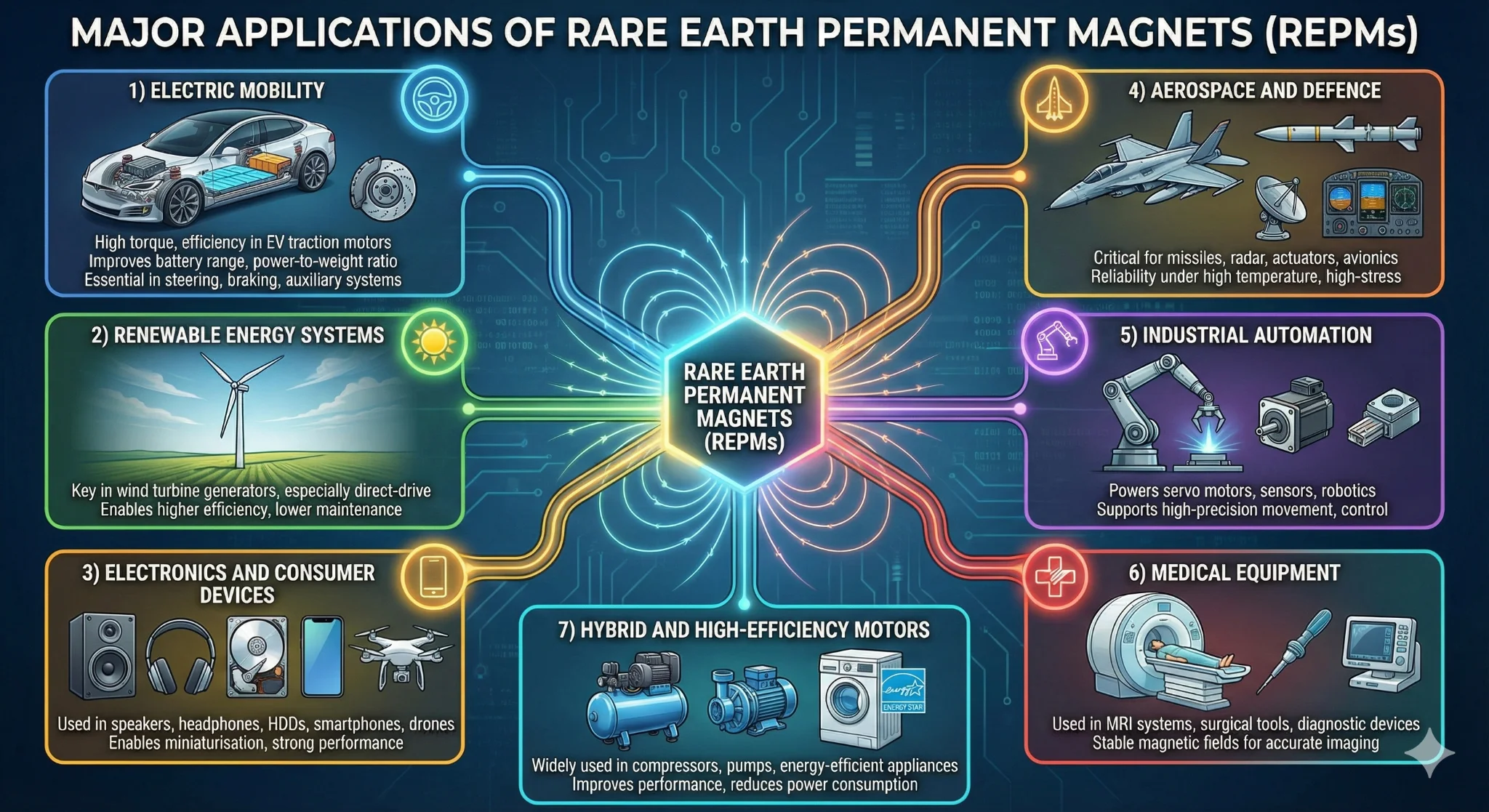Important Facts For Prelims
Scheme to Promote Manufacturing of Sintered Rare Earth Permanent Magnets
- 28 Nov 2025
- 7 min read
Why in News?
The Union Cabinet has approved the Scheme to Promote Manufacturing of Sintered Rare Earth Permanent Magnets, a Rs 7,280-crore, seven-year programme aimed at building domestic Rare Earth Permanent Magnets (REPM) capacity.
What are the Key Facts About Scheme to Promote Manufacturing of Sintered Rare Earth Permanent Magnets?
- About: The scheme seeks to establish 6,000 million tonnes per annum (MTPA) of integrated REPM manufacturing capacity in India.
- The scheme supports complete value-chain integration, covering the conversion of oxides to metals, metals to alloys, and alloys to finished sintered magnets.
- This will help India develop its first-ever domestic REPM manufacturing ecosystem, reducing external vulnerabilities.
- Incentive Structure: The financial package includes Rs 6,450 crore in sales-linked incentives over five years and Rs 750 crore in capital subsidy.
- These incentives aim to attract major investors, promote large-scale production, and ensure global competitiveness of Indian-made rare earth magnets.
- Beneficiary Allocation: A total manufacturing capacity of 6,000 MTPA will be distributed among five beneficiaries selected through global competitive bidding.
- Each beneficiary may receive up to 1,200 MTPA, ensuring balanced participation and strong industrial competition.
- Duration of the Scheme The scheme will run for 7 years, comprising a 2-year gestation period for facility setup and 5 years of incentive disbursement.
- This phased approach ensures adequate time for infrastructure creation and sustained production.
- Need: India’s demand for rare earth permanent magnets is set to double by 2030, yet the country remains heavily import-dependent, bringing in over 53,000 metric tonnes in 2024–25.
- With China controlling the supply chain and tightening export rules, Indian EV and auto makers faced delays, supply uncertainty, higher costs, and production risks.
- These challenges prompted industry calls for support, making domestic REPM manufacturing crucial for reducing import dependence and boosting technological self-reliance.
- Strengthening domestic manufacturing will improve supply chain resilience, support clean mobility, enhance energy security, and align with India’s long-term targets under Net Zero 2070 and Viksit Bharat 2047.
What are the Rare Earth Permanent Magnets (REPMs)?
- About: REPMs are high-performance magnets made from rare earth elements such as samarium (Sm), neodymium (Nd), praseodymium (Pr), dysprosium (Dy), and cerium (Ce).
- Compared to ferrite or AlNiCo magnets, REPMs offer a much higher maximum energy product, greater coercivity, stronger magnetic output in compact sizes, and superior performance in high-precision or high-power applications.
- This makes them indispensable for high-efficiency motors and miniaturised devices.
- Sintered REPMs: These are produced through a process called sintering, where fine rare-earth alloy powders are compacted under pressure and then heated at high temperatures to form dense, strong magnetic structures.
- These magnets especially sintered NdFeB (neodymium-iron-boron) and SmCo (samarium-cobalt) magnets are the strongest commercially available permanent magnets and are essential for high-efficiency electric motors and advanced technological applications.
- Importance of REMPS for India’ EV Ecosystem: Rare earth magnets, especially NdFeB types, are vital for EV traction motors, steering, braking, and other components, improving efficiency, power output, and battery range.
Frequently Asked Questions (FAQs)
Q. What is the objective of the REPM manufacturing scheme?
To establish an integrated domestic ecosystem for sintered Rare Earth Permanent Magnets with 6,000 MTPA capacity, reducing import dependence and securing supply for EVs, defence and high-tech sectors.
Q. How will beneficiaries be chosen and allocated capacity?
Five beneficiaries will be selected through global competitive bidding; each may receive up to 1,200 MTPA to ensure balanced participation and industrial competition.
Q. Why is domestic REPM manufacturing strategically important for India?
It mitigates supply-chain risks from concentrated global suppliers (notably China), secures critical inputs for EV motors, renewables and defence, and advances technological self-reliance.
UPSC Civil Services Examination, Previous Year Questions (PYQs)
Q. Recently, there has been a concern over the short supply of a group of elements called ‘rare earth metals’. Why? (2012)
- China, which is the largest producer of these elements, has imposed some restrictions on their export.
- Other than China, Australia, Canada and Chile, these elements are not found in any country.
- Rare earth metals are essential for the manufacture of various kinds of electronic items and there is a growing demand for these elements.
Which of the statements given above is/are correct?
(a) 1 only
(b) 2 and 3 only
(c) 1 and 3 only
(d) 1, 2 and 3
Ans: (c)







